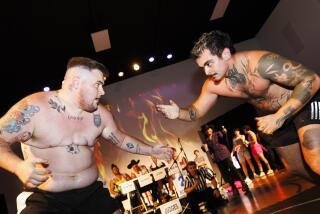Op-Ed: How I nurtured my trans nonbinary childâs path â and learned to grow with him

Two years ago, my then 7-year-old and I were having a date night when I jokingly asked, âAny deep, dark secrets you want to share with me?â E was quiet for a moment, then said, âYou know, how when itâs piano recital time, and me and B always get to pick out a dress? Well, what I really want is a tuxedo.â
The thought of E in a bow tie and jacket made me smile, so I instantly said yes, and E was excited in a way that made me take notice. Before that night together, he was somehow getting dimmer, more internal. Voice barely a whisper. Always close to my legs. But, over the next few months, when he made other requests â to wear boy swim shorts instead of last yearâs one piece as well as boxer briefs to bed, to use the boyâs restroom â and we said yes, E grew brighter. Thatâs the only way to describe it. Eyes bright. Smile wide.
Behind the scenes, though, I set out swiftly to educate myself, my husband, Allan, and my older daughter B, on how best we could support him.
It was the pandemicâs beginning, and we had the freedom to deepen our understanding of the difference between biological sex and gender; learn the differences between trans nonbinary, gender fluid and queer; and read up on the beautiful, long history of trans and nonbinary people throughout history.
We learned incredible stories from India, Pakistan and America, where they were healers and shamans in their communities. And we discovered our countryâs long history of trans educators and activists such as Miss Major Griffin-Gracy, Sylvia Rivera and Marsha P. Johnson.
My husband and I began to follow educators online like artist Alok Vaid-Menon, Jonathan Van Ness of the âQueer Eyeâ television show and TikTok creator Jeffrey Marsh. We listened to their stories, believed their lived experiences. Their posts were and continue to be daily lessons in generosity and kindness, teaching the public about what it means to be trans nonbinary, an ally and a compassionate human.
We learned that using Eâs chosen pronouns reduced depression, anxiety and suicidal ideation. So, several months later, on our next date night when I asked E again, âAnything you want me to know?â And he shared, âSometimes I feel like a girl, but sometimes I also feel like a boy. Could you call me a boy?â I knew the only answer was, âOf course, Bug!â squeezed him tight, while he shimmered.
From the moment E shared his pronouns with us, it felt like a celebration â that, first and foremost, he trusted us. He felt safe enough to tell us how he was feeling. And then, that incredible brightness, beaming into every room he entered. It was clear: When we respected Eâs pronouns, he shined.
Still, navigating the world outside our bubble proves challenging. Multiple well-intending friends whisper-warn at the park, grocery store and parties not to give E meds or rush into surgeries. I kindly yet clearly explain parents are not giving irreversible medication or surgeries to their children, that young children cannot have gender-affirming surgeries and that delaying puberty with hormonal care allows trans nonbinary kids more time to discover who they are. Parents are not rushing children to become trans nonbinary. Itâs the opposite â most parents I know are worried that their kids will be bullied and harmed if they come out as trans nonbinary.
Transgender youth make up only 1.4% of the U.S. population. And there is not an overuse of hormonal care or gender-affirming surgeries. A 2020 study published in the National Library of Medicine surveyed more than 20,000 trans adults ages 18 to 36, and 16.9% of them said that they had wanted pubertal suppression as youths. Only 2.5% of the participants ultimately received such hormone treatment. As for surgeries, another study found 25% of trans nonbinary people report having surgeries as adults. Of that percentage, their regret rate is only 1%.
Then, there are the neighbors who say itâs a trend â that liberal parents are making their kids trans. I have to remind myself to pause, breathe deep, find the ground beneath me, then clearly explain that parents are not telling young kids that they could be trans nonbinary. What parents like me are doing is allowing for curiosity when their child bravely shares that their gender doesnât match their sex assigned at birth.
I share with these friends and neighbors that this year, states filed hundreds of anti-LGBTQ bills, most targeting trans people. Here in Utah, where we live, a ban on trans kids from sports teams passed before a judge reversed it, only delaying the ban. I tell them about tattletale laws â such as doctors reporting young people receiving puberty-blocking drugs to the authorities â and how I sometimes wake up at night scared that allowing E to be himself fully may come with accusations from strangers, leading to having to defend my family.
On a recent weekend, at the farmers market, E pointed out two pins âone said, âI love my trans kid,â and another, âI love my trans sibling.â I purchased them, and B and I put them on. E held my hand sparkling.
Some people have warned, âWhat if E changes his mind?â
My answer is always: âHe can change his mind as much as he wants. That is what being gender fluid is.â I hope E continues to change his mind â to be curious, explore, grow, shift and change. I hope E always feels free to be who he is, shine in this new and glorious way, and know that I am in his corner, no matter what.
Rebecca Brenner is a writer based in Park City, Utah.
More to Read
A cure for the common opinion
Get thought-provoking perspectives with our weekly newsletter.
You may occasionally receive promotional content from the Los Angeles Times.










